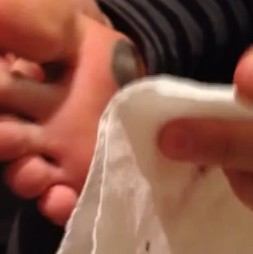A blood blister may occur on hands and feet, and it is a type of blister, which forms when the subdermal tissue and blood vessels become damaged without piercing skin. This kind of blister consists of a pool made of lymph fluid, blood, and other body fluids that are trapped beneath skin. When punctured, the blister oozes a dark fluid.
At times, the fluid may be cut off from the other part of body and it dries out thereby leaving dead cell materials inside that blister. In this case, it forms a texture like that of putty. Some of the blisters may be painful and uncomfortable because of bruising where the blistering occurs. You might be wondering should you pop a blood blister.
Well, blood blisters can heal naturally on their own when they are not punctured or pierced, and you might want to consider leaving them to heal on their own.
Causes and symptoms
The red, black, purple discoloration you see in a blood blister is caused by traces of blood as the name suggests. It means there is blood inside the blister. But when you examine the anatomy of skin, you will find that there aren’t blood vessels in the epidermis where these blisters form. In skin, the blood vessels are located deeper in the dermis, which is below the epidermis.
Therefore, one may ask, how does blood end up in the blood blister formed on the upper skin layer. The answer to this is that, the presence of blood in the blister is an indication there has been an injury that occurred deeper in skin tissue with a significant pressure. This is one reason why you find that blood blisters often form over bony prominences and joints such as the toes, back of heel, and at the ball of foot or metatarsal heads.
The excess pressure usually raptures capillaries, which in turn causes bleeding that tracks into the blister. When you have high friction combined with excessive localized pressure, you are likely to get a blood blister. The blood coming from the dermis will stain the cells it gets into contact with causing the dark, purple discoloration.
Blood blisters are mainly caused by accidents whereby the skin is pinched by a tool, heavy weight, or physical force. These blisters may form due to forcible human contact such as grappling. With constant rubbing forth and back, you may have blood blisters forming on hands or foot. When there is trauma on skin such as burning, scalding, exposure to chemical, forceful pinching, or allergen on skin as well as viral and fungal infection, blood blisters can form.
A gradual application of friction for example from new shoe rubs, it may also cause blood blisters to form on the foot. When a blood blister first develops, it may be very painful. It resembles a friction blister in shape and size but there is a difference in that it appears dark due to the small amount of blood that is trapped in between layers of skin.
Treatment of blood blisters
Blood blisters are similar to the normal skin blisters and may not require medical attention. When left alone, they can heal naturally without treatment. New skin forms beneath the blister to allow it to start healing, and within a week or so, you may have it completely healed. However, if the blister is accidentally pierced or punctured, a small amount of blood may escape but the skin feels raw and very painful.
It is advisable that blisters are covered with a soft dressing that is sterilized. They should be washed frequently in order to keep them free of irritants. Leaving the blisters open may expose them to secondary infection such as bacteria. In the event that the blister breaks, an individual should treat it using antiseptic ointment in order to prevent infection from occurring.
Even if the blister raptures, it is paramount that the skin that is covering it is left intact. The layer of skin over the blisters provides a natural protection from infections that may be caused by bacteria. Nonetheless, if the blister does not heal on its own, it might require one to seek treatment. One might notice signs of infections such as redness, warmth, or inflammation, and these should be examined by a physician.
Should you pop a blood blister?
In essence, blood blisters should not be popped as this could expose one to infections by opening the skin over the blister. It also causes pain when it raptures and the best thing to do is to leave it to heal naturally. Try to remove any pressure on blister roof to prevent it from rupturing. Taking away pressure such as not wearing shoes or wearing open toed sandals if you have a blood blister on top of the toe, it may help keep the blister intact with no chances of infections.
